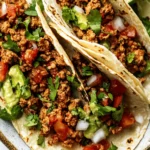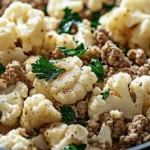This fruitcake recipe is a cherished family tradition, passed down from a 90-year-old grandmother. It’s simple to make with dried fruit and requires no soaking. The cake keeps well in an airtight tin, making it perfect for the holidays.
FULL RECIPE:
Ingredients
- 1 cup (150g) mixed dried fruit
- 1/2 cup (120ml) orange juice
- 1/2 cup (113g) unsalted butter, softened
- 1 cup (200g) granulated sugar
- 2 large eggs
- 1 1/2 cups (190g) all-purpose flour
- 1/2 teaspoon baking powder
- 1/2 teaspoon baking soda
- 1/4 teaspoon salt
- 1/2 teaspoon ground cinnamon
- 1/4 teaspoon ground nutmeg
- 1/4 teaspoon ground cloves
- 1/2 cup (60g) chopped nuts (optional)
Directions
- Preheat Oven: Set your oven to 325°F (163°C). Grease and flour a 9-inch (23cm) round cake pan.
- Prepare Fruit Mixture: In a small bowl, combine the mixed dried fruit and orange juice. Let it sit for at least 15 minutes to allow the fruit to absorb the juice.
- Cream Butter and Sugar: In a large bowl, cream together the softened butter and granulated sugar until light and fluffy.
- Add Eggs: Beat in the eggs one at a time, ensuring each is fully incorporated before adding the next.
- Combine Dry Ingredients: In a separate bowl, whisk together the all-purpose flour, baking powder, baking soda, salt, ground cinnamon, ground nutmeg, and ground cloves.
- Mix Wet and Dry Ingredients: Gradually add the dry ingredients to the creamed mixture, mixing well after each addition.
- Add Fruit and Nuts: Stir in the soaked dried fruit along with any remaining juice. If using, fold in the chopped nuts.
- Pour into Pan: Transfer the batter into the prepared cake pan, spreading it evenly.
- Bake: Bake in the preheated oven for about 60 minutes, or until a toothpick inserted into the center comes out clean.
- Cool: Allow the cake to cool in the pan for 10 minutes before transferring it to a wire rack to cool completely.
Nutrition Facts
- Serving Size: 1 slice (1/16 of the cake)
- Calories: 230
- Total Fat: 9g
- Saturated Fat: 5g
- Cholesterol: 45mg
- Sodium: 150mg
- Total Carbohydrates: 35g
- Dietary Fiber: 1g
- Sugars: 25g
- Protein: 3g
History and Significance of Fruitcake
Fruitcake is one of the oldest and most cherished desserts in the world, with roots tracing back to ancient Rome. Early versions of fruitcake included pomegranate seeds, pine nuts, and raisins mixed into a barley mash. As trade routes expanded, new ingredients such as spices, honey, and preserved fruits were incorporated, making fruitcake an essential part of many cultural traditions. During the Middle Ages, fruitcake became popular in Europe, where dried fruits, nuts, and honey were added for a richer flavor. It was particularly favored in Britain, where it became a staple at celebrations such as weddings and Christmas. In the Victorian era, fruitcake was considered a luxury item, often adorned with marzipan and royal icing for an elegant presentation.
Why Fruitcake is a Holiday Favorite
One of the main reasons fruitcake is so closely associated with the holiday season is its long shelf life. Unlike other baked goods that spoil quickly, fruitcake can last for weeks or even months if stored properly. This made it an ideal treat for families who wanted to prepare desserts in advance for Christmas and New Year’s celebrations. The combination of dried fruits, nuts, and spices also makes fruitcake a warm and comforting dessert, perfect for cold winter months. Many families have their own fruitcake recipes, passed down through generations, adding sentimental value to this holiday treat.
Different Variations of Fruitcake Around the World
Fruitcake takes on many different forms depending on the region. Here are some notable variations:
- British Fruitcake: Traditional British fruitcake is rich, dense, and often covered with a layer of marzipan and royal icing. It is typically served at weddings and Christmas.
- German Stollen: This version of fruitcake is lighter in texture and filled with nuts, spices, and candied citrus peels. Stollen is dusted with powdered sugar and often contains a marzipan filling.
- Italian Panettone: A fluffy, bread-like fruitcake that originated in Milan, Italy. It has a slightly sweet taste and is filled with raisins and candied citrus peels.
- Caribbean Black Cake: A darker, rum-soaked version of fruitcake popular in the Caribbean. It is rich, moist, and often made with dried fruits that have been soaked in rum for months.
- American Fruitcake: Typically dense and filled with bright red and green candied fruits, American fruitcakes are often sold in decorative tins during the holiday season.
Tips for Making the Perfect Fruitcake
Making fruitcake requires patience and precision, but with the right techniques, you can create a flavorful and moist cake that is anything but dry or heavy. Here are some tips:
- Soak Your Fruits: To enhance the flavor and moisture content, soak your dried fruits in rum, brandy, or fruit juice for at least 24 hours before baking.
- Use Quality Ingredients: Fresh nuts, dried fruits, and high-quality butter make a significant difference in the final taste.
- Don’t Overmix the Batter: Overmixing can result in a dense, tough texture. Mix just until the ingredients are combined.
- Bake at a Low Temperature: Fruitcake is best baked at a low temperature (around 300°F or 150°C) to ensure even cooking and prevent the outer layer from burning.
- Wrap and Store Properly: After baking, wrap the fruitcake in parchment paper and store it in an airtight container. Some people prefer to “feed” their fruitcake with a small amount of liquor over several weeks to enhance its flavor.
Common Mistakes When Making Fruitcake
While fruitcake is a relatively straightforward dessert to make, there are a few common mistakes that can lead to disappointment:
- Using Too Many Fruits or Nuts: Overloading the cake with fruits and nuts can prevent the batter from binding properly, leading to a crumbly cake.
- Skipping the Soaking Process: Dried fruits that haven’t been soaked can make the cake dry and tough.
- Baking at High Temperatures: Fruitcake requires slow and even baking. A high temperature can cause the outside to burn while the inside remains undercooked.
- Not Letting It Rest: Fruitcake tastes better after resting for a few days or even weeks. This allows the flavors to meld and develop fully.
Health Benefits of Fruitcake
While fruitcake is often considered an indulgent treat, it does offer some nutritional benefits when made with wholesome ingredients:
- Rich in Fiber: Dried fruits such as raisins, dates, and apricots are high in dietary fiber, which supports digestion.
- Good Source of Healthy Fats: Nuts like almonds and walnuts provide heart-healthy fats and essential nutrients.
- Packed with Antioxidants: Many dried fruits contain antioxidants that help combat oxidative stress and inflammation in the body.
- Natural Energy Boost: The combination of dried fruits and nuts makes fruitcake a great source of energy, perfect for holiday festivities.
Conclusion
Fruitcake is a timeless dessert that has been enjoyed for centuries and remains a beloved holiday tradition. Whether you prefer the classic British fruitcake, the light and airy Italian Panettone, or the rich and flavorful Caribbean Black Cake, there is a version of fruitcake to suit every taste. By using high-quality ingredients, following proper baking techniques, and allowing the cake to rest for a few days, you can create a moist and delicious fruitcake that will impress your family and friends. Whether enjoyed as a Christmas treat or given as a thoughtful homemade gift, fruitcake continues to be a cherished part of holiday celebrations around the world.






